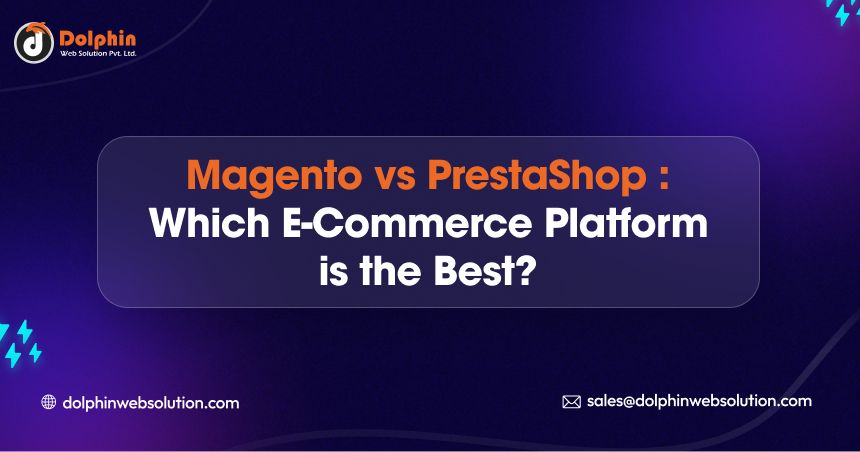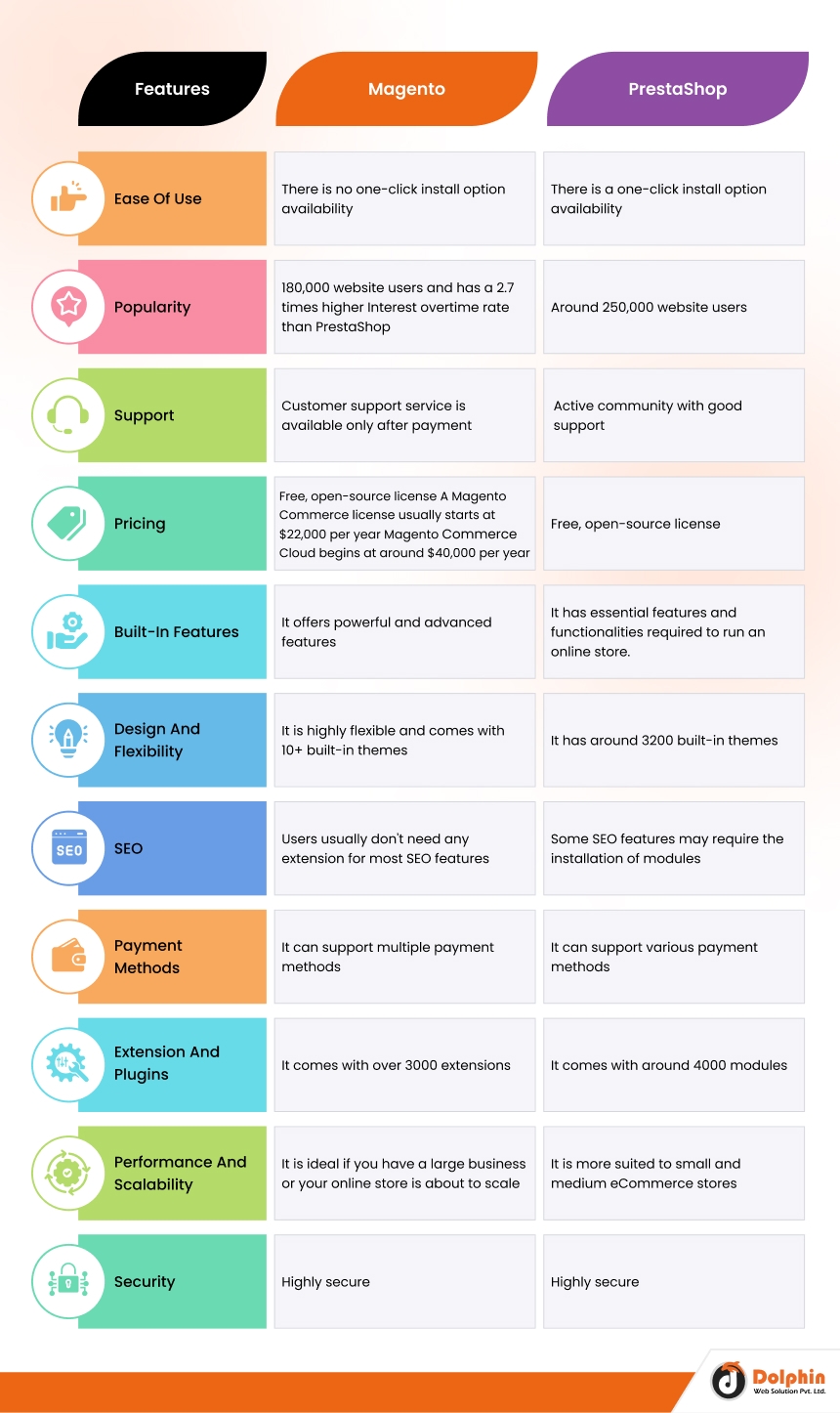Magento vs PrestaShop: Which eCommerce Platform is the Best?

Table of Contents
Summary :
Magento and PrestaShop are popular eCommerce platforms with distinctive features to meet various business needs. Read the comparison below to choose the ideal one for your business.
What is Magento?
It would help if you chose an ideal shopping cart solution to scale and grow your online business. With hundreds of eCommerce platforms available, choosing the platform that suits your unique business needs is essential. It would help if you considered several factors when choosing the right platform for an online store. Magento and PrestaShop are the chart toppers for the most popular eCommerce platforms.
Magento is a popular eCommerce platform for developing robust online stores with advanced functionality. It has powerful tools to create and scale your eCommerce business. PrestaShop is another highly customizable eCommerce platform with intuitive use and is excellent for international distribution. PrestaShop offers more ease of use and remade themes, while Magento provides more powerful features and scalability options. This article compares these two powerful eCommerce platforms by understanding their pros and cons to help you choose the perfect solution for your online business.
Magento is a robust, open-source eCommerce platform with over 170,000 users. It is the 8th most widely used eCommerce platform globally, and stores built using it are reported to grow three times faster. When it comes to customization and advanced features, this platform is unbeatable. Also, around 26% of users have upgraded to Magento 2, which also comes with various advanced extensions and apps.
Pros
- Magento comes with an Enterprise version to meet the business needs of large-scale online businesses
- It can handle up to 50,000 visits with ease per hour
- Magento has an extensive range of extensions and a community of robust website developers
- If you plan to scale your eCommerce store, Magento will allow you to do so with precision, flexibility, and smoothness
- Magento has built-in features such as loyalty program management, high volume selling, advanced built-in features, seamless check-out, and secure payment options
Cons
- Besides regular expenses such as functionality upgrades, ongoing maintenance costs, and plugin software, two other costs can make it a tad expensive
- Magento needs dedicated servers as this platform is a feature-loaded, resource-incentive solution
- Magento requires high coding expertise, for which business owners need to hire reliable developers
- If your technical experience is not sound and you are not planning to hire a developer, then Magento as a platform may not be ideal
- Magento installation, administration, and modification need advanced technical skills
What is PrestaShop?
PrestaShop is an open-source, feature-rich eCommerce platform that has around 250,000 users across the globe. This platform is convenient to use and is accessible.
Pros
- Budget-friendly platform
- PrestaShop is ideal for you if you are looking for a low-investment eCommerce platform
- User-friendly option
- This platform also comes with a simple backend interface and design
Cons
- Limited Scalability Options
- PrestaShop is more suited to small and medium eCommerce stores
- It may experience lags such as poor backend performance, slow page loading speed, etc
- PrestaShop is not ideal for big e-commerce businesses
Magento vs Prestashop: A Detailed Comparison
Now that we know both platforms’ pros and cons, let’s move on to the Magento vs. PrestaShop differences.
| Features | Magento | PrestaShop |
|---|---|---|
| Ease of Use | There is no one-click install option availability | There is a one-click install option availability |
| Popularity | 180,000 website users and has a 2.7 times higher Interest overtime rate than PrestaShop | Around 250,000 website users |
| Support | Customer support service is available only after payment | Active community with good support |
| Pricing | Free, open-source license A Magento Commerce license usually starts at $22,000 per year Magento Commerce Cloud begins at around $40,000 per year |
Free, open-source license |
| Built-in features | It offers powerful and advanced features | It has essential features and functionalities required to run an online store. |
| Design and flexibility | It is highly flexible and comes with 10+ built-in themes | It has around 3200 built-in themes |
| SEO | Users usually don’t need any extension for most SEO features | Some SEO features may require the installation of modules |
| Payment methods | It can support multiple payment methods | It can support various payment methods |
| Extension and Plugins | It comes with over 3000 extensions | It comes with around 4000 modules |
| Performance and Scalability | It is ideal if you have a large business or your online store is about to scale | It is more suited to small and medium eCommerce stores |
| Security | Highly secure | Highly secure |
Now, let us move on to a detailed comparison of these two platforms.
Magento vs PrestaShop: Ease of Use
It is difficult for a non-tech person to install and set up a Magento store manually. It can be challenging and time-consuming. Usually, business owners must hire Magento developers to set up their stores.
Installing and setting up a PrestaShop store is easy. It is easier to operate than a Magento store as other features, such as product category, product description, order, etc, are displayed clearly on the website’s dashboard. Hence, PrestaShop is more straightforward to use than Magento.
Magento vs PrestaShop: Design and Theme Options
When designing your eCommerce store, themes play an important role. Also, if you want to offer a unique experience to your users, you can opt for plugins and extensions. Magento and PrestaShop have built-in themes you can purchase if you don’t want to build them from scratch.
Magento has an official theme directory with limited theme availability. Also, Magento 2 allows you to choose premium themes for your store. PrestaShop, in contrast, has over 3200 pre-made themes. Both these platforms allow users to modify the articles.
Magento vs PrestaShop: SEO and Marketing Features
Magento offers unparalleled SEO capabilities. This powerful platform has multiple default functionalities and boosts your SEO rankings. Magento 2 allows users to manage content, promotions, and communication.
PrestaShop also had default SEO features to drive more traffic and improve rankings.
Magento vs PrestaShop: Extensions and Add-Ons
Magento offers multiple unpaid and paid extensions to support complex stores. It provides 5000+ extensions that can be easily integrated with your Magento backend. Dolphin web solution Magento extension shop serves various functions, such as improving customer experience, sales, and functionalities. PrestaShop also offers 4000+ modules that can boost the performance and functionality of a primary eCommerce store.
Magento vs PrestaShop: Cost
The open-source Magento version is free, and the CMS can be customized for business needs later. Users have to pay for the Magento hosting and additional plugins. Similarly, you have to pay for PrestaShop web hosting and add-ons. However, when it comes to large-scale online stores, Magento is more cost-efficient than Prestashop. Also, the cost to hire a Magento developer offers more value as Magento stores are scalable and robust.
Magento vs PrestaShop: Security
Magento security patches allow users to fix security issues every 10-15 days. Also, Magento security extensions and third-party tools are available for advanced security. PrestaShop offers PCI-compliant stores to ensure high safety for the store and customers. However, Magento has more robust security features than PrestaShop.
Magento vs PrestaShop: Which One is Best for Your Business
Regarding PrestaShop vs Magento, here is all you need to know. Magento has more advanced features than PrestaShop but needs a Magento development company to install, manage, and operate it. If you are running a large online store and have a budget to spare, then Magento is ideal. But if you are starting an online store, you can use PrestaShop owing to its ease of use and pre-built themes. Let’s have it in a gist,
- Magento is more feature-rich
- PrestaShop, but requires a technical expert. Magento is the best for a high-budget project
- PrestaShop is great for beginners, is cheap, simple, and is widely used for small businesses
Conclusion
PrestaShop and Magento have great features and functionalities to run an online store. PrestaShop is usually easier to use and is best suited for medium and small online stores. Magento outperforms other platforms when running an extensive eCommerce store with a high visitor volume. Magento will be ideal if you are willing to create a fully functional, highly secure, and scalable online store.





